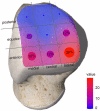Acute, isolated and unstable syndesmotic injuries are frequently associated with intra-articular pathologies
- PMID: 32728787
- PMCID: PMC8038950
- DOI: 10.1007/s00167-020-06141-y
Acute, isolated and unstable syndesmotic injuries are frequently associated with intra-articular pathologies
Abstract
Purpose: Although simultaneous arthroscopy for the surgical treatment of acute isolated, unstable syndesmotic injuries has been recommended, little knowledge is present about the actual frequency of intra-articular pathologies for this injury. The aim of this study was to investigate the frequency and severity of intra-articular pathologies detected during arthroscopy and their subsequent treatment in acute isolated, unstable syndesmotic injuries.
Methods: A retrospective chart review of patients treated by arthroscopic-assisted stabilization for acute isolated, syndesmotic instability was performed. The primary outcome parameter was the frequency of intra-articular pathologies. Secondary outcome parameters were the type of syndesmotic lesion (ligamentous/bony), severity of chondral lesions, MRI findings, treatment details, complications and the identification of factors associated with intra-articular pathologies.
Results: Twenty-seven patients, 19% female, with a mean age of 37 ± 12 years met the inclusion criteria. 70% suffered isolated ligamentous injuries, the remaining suffered avulsion fractures of the syndesmosis. Chondral lesions occurred in 48% (ICRS grade II: 33%; ICRS grade IV 15%) and intra-articular loose bodies in 11% of patients. Overall, arthroscopy revealed intra-articular pathologies necessitating further treatment in 19% of patients. Neither the type of syndesmotic injury (bony vs. ligamentous; ns) nor the degree of ligamentous instability (West Point IIB vs. III; ns) had a significant influence on the occurrence of chondral lesions. One complication (SSI) occurred. Pre-operative MRI revealed a sensitivity/specificity of 100/79% for chondral lesions and 50/93% for loose bodies.
Conclusion: Intra-articular pathologies in acute isolated, unstable syndesmotic injuries occur in up to 50% of patients, 19% necessitated additional treatment. Simultaneous arthroscopy, independent of the pre-operative MRI findings, appears reasonable in highly active patients.
Level of evidence: Level III.
Keywords: Arthroscopy; Chondral lesions; High ankle sprains; Surgery; Syndesmosis; Syndesmotic injury.
Conflict of interest statement
There is no potential conflict of interest of any of the authors. This manuscript has not been published elsewhere and is not under consideration by another journal. All authors agree with the submission to KSSTA.
Figures


References
-
- Bauer JS, Barr C, Henning TD, Malfair D, Ma CB, Steinbach L, Link TM. Magnetic resonance imaging of the ankle at 3.0 Tesla and 1.5 Tesla in human cadaver specimens with artificially created lesions of cartilage and ligaments. Investig Radiol. 2008;43(9):604–611. doi: 10.1097/RLI.0b013e31817e9ada. - DOI - PubMed
-
- Beumer A. Chronic instability of the anterior syndesmosis of the ankle. Acta Orthop. 2009;78(Supp 327):2–40. - PubMed
MeSH terms
LinkOut - more resources
Full Text Sources
Medical
Research Materials
Miscellaneous

